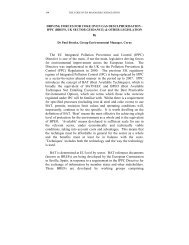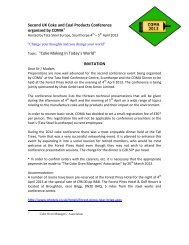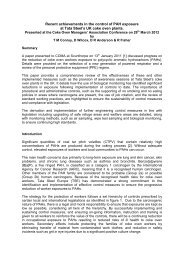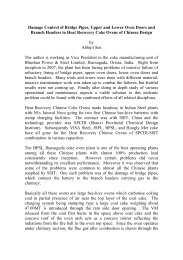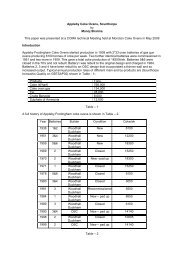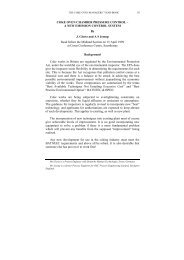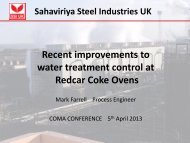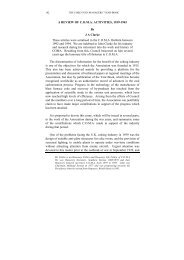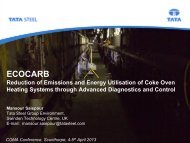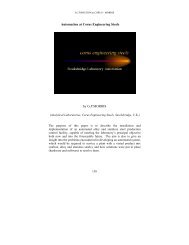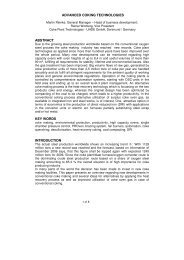THE YEAR-BOOK OF THE COKE OVEN - Coke Oven Managers ...
THE YEAR-BOOK OF THE COKE OVEN - Coke Oven Managers ...
THE YEAR-BOOK OF THE COKE OVEN - Coke Oven Managers ...
Create successful ePaper yourself
Turn your PDF publications into a flip-book with our unique Google optimized e-Paper software.
coke handling processes with beehive ovens operators. Written procedures were<br />
also not found for quality assurance activities like sampling, sample preparation<br />
and analysis of coal and coke. With respect to coal handling system, it was<br />
observed that no distinct demarcation was being maintained between various<br />
received coals (Semi Soft / Jamadoba/ HCC (imported hard coking coal) / WB<br />
(west bokaro) and blended coal) in the premises of beehive ovens. Different<br />
types of coal had no nameplates or display board for proper identification.<br />
Various individual coals were dumped haphazardly near the blended coal. Coals<br />
were stored in open areas which resulted in moisture gain during rains. It was<br />
also observed that process was not followed for coal usage based on the<br />
principle of “first in, first out” (FIFO) to avoid usage of weathered coal. Latest<br />
received coals were being utilized first. Crushing fineness of blended coals was<br />
inadequate. Stock management of various coals was poor.<br />
Assessment of old practices of coke quenching and handling system at beehive<br />
coke ovens was carried out. It was observed that the time elapsed between coke<br />
pushing and coal charging was very high and varying. The heat condition of the<br />
battery was poor which resulted in green coke pushing (un-carbonized / partially<br />
carbonized coke). This might led to the weakening of coke and generation of<br />
fines. Leakages through the door were noticed. In some of the ovens, whole<br />
bricks from the door were collapsed before coke pushing. Poor sealing of doors<br />
and opening of oven top covers was found in a number of ovens. Cracks on<br />
walls were also observed. Carbonization time was not being adjusted according<br />
to the coal moisture to get good quality of coke. After pushing from ovens, coke<br />
was not quenched immediately due to unpreparedness of quenching system<br />
which resulted in coke burning. Lots of green pushing was observed because of<br />
poor process control.<br />
It was observed that a single big hosepipe was being utilized for coke quenching<br />
with water. This led to requirement of more volume of water for completing the<br />
coke quenching because single stream of water could not cover entire hot coke<br />
pile at a time. This resulted in high moisture (15-17%) in dispatched coke. High<br />
moisture in coke resulted in sticking of fines on lump coke. It was also noticed<br />
that for coke quenching, uncontrolled and continuous single stage quenching<br />
operation was practiced. Quenching was being done continuously for 15-25<br />
minutes duration. Also, the quenching of coke was practiced without dispersing<br />
the red hot coke pile after the pushing. This caused inadequate quenching of hot<br />
coke inside the pile and restricted removal of fines. Velocity of water in single<br />
hosepipe was not sufficient to flush out the fines. Other observations were made<br />
6



